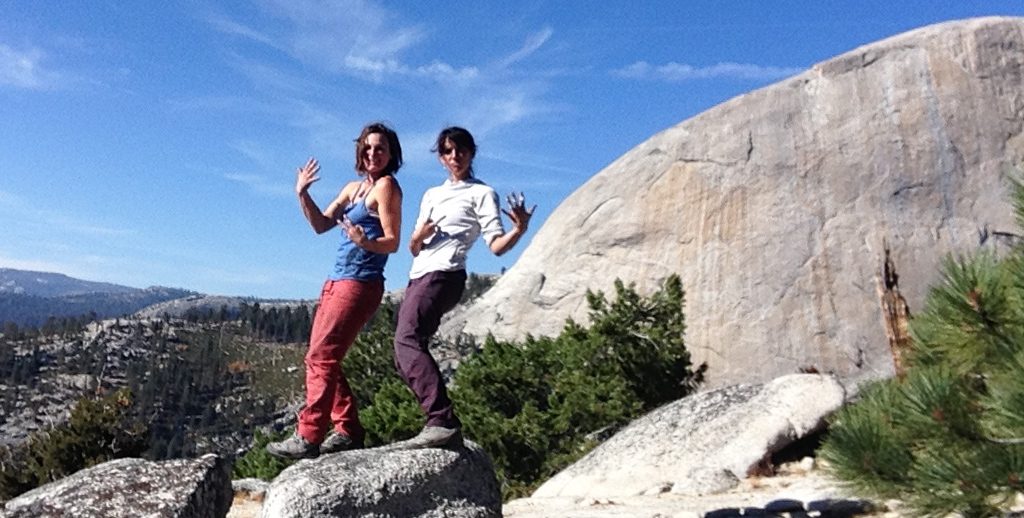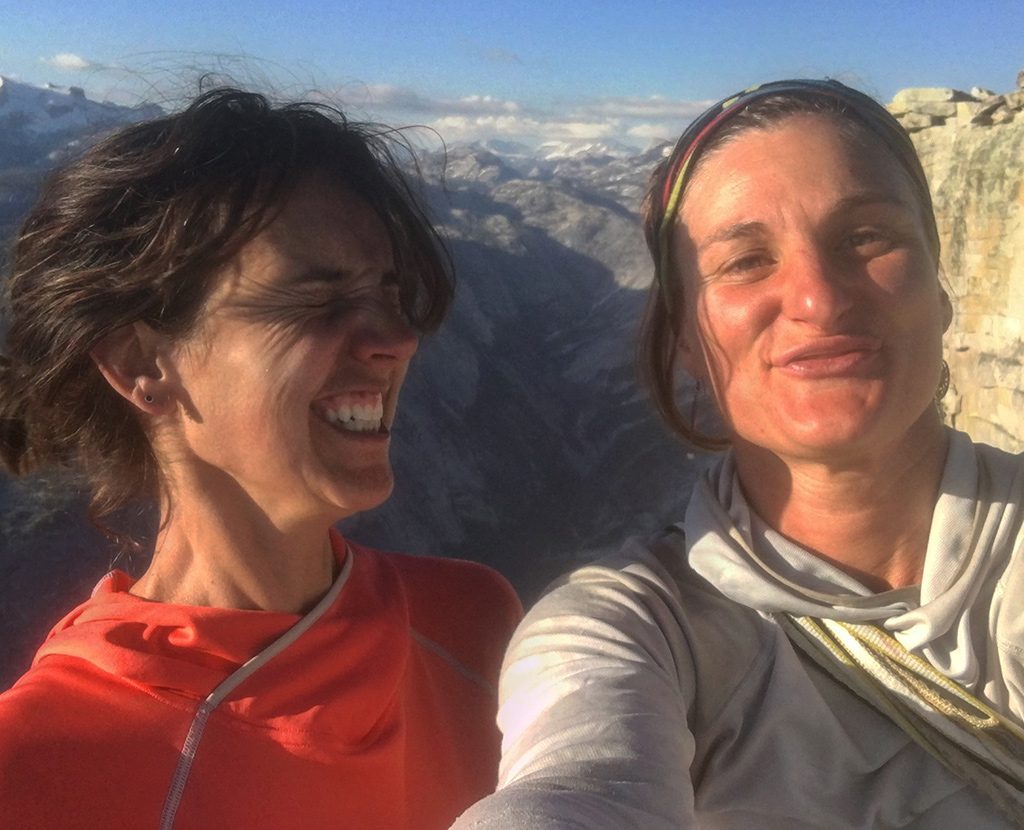Op-Ed: The Thing About Climbing Media and First Female Ascents
And the importance of women climbing together
Last fall, Quinn Brett and Josie McKee set five potential speed records in Yosemite during what they refer to as their “Tour de Ditch.” Over the course of a week, the two climbed El Capitan, Lost Arrow Spire, Leaning Tower, Mt. Watkins, Washington Column, Half Dome and Liberty Cap. That’s a grand total of seven Grade V or VI big walls in seven days, a feat the likes of which mere mortals (and even seasoned climbers) can barely comprehend.

Quinn Brett and Josie McKee celebrate the completion of their “Tour de Ditch.” | Photo Courtesy
“Similar projects have been done by male climbers, but I hadn’t heard of any females teams pushing the climbing endurance envelope in that regard,” Brett said of the project.
Aside from a nod in Alpinist magazine, their accomplishment remained mostly unacknowledged. (Meanwhile, Adam Ondra or Alex Honnold might sneeze near some granite and get a New York Times mention.) It’s not as if Quinn and Josie are unknown climbers or that Yosemite is in any way under the radar.
In 2016, Josie became the second woman to solo The Nose in a day and is well-known for her climbing in Patagonia. Quinn, who set a speed record on the Nose in 2012, puts up first ascents around the world, from the Rockies to Greenland. It leaves one wondering what kind of alpine wizardry it would take to earn a female climbing team the same attention routinely afforded men in the sport.
Greater numbers of women in climbing will add to the number of women pushing limits.
Perhaps media coverage of women’s climbing is proportional to the number of women participating in the sport. Josie, who is also a senior Yosemite Search and Rescue (YOSAR) member, said that she commonly sees more men climbing than women, whether it’s at a hostel in El Chalten or sport climbing in Lander. The numbers or lack thereof, she said, could be part of what keeps women out of the news.
“Greater numbers of women in climbing will add to the number of women pushing limits and therefore the demand to hear about their achievements in the news,” Josie said.
Quinn, on the other hand, said she’s becoming less and less convinced that the lack of press is a numbers problem. She said she has a hard time wrapping her head around publicity in general because she’s not sure what she should expect of the coverage of her feats. Just because she is proud of her own efforts and hears positive feedback from those within her community, she said, doesn’t mean what she does necessarily translates into popular consumptive material. The attention isn’t why she climbs, anyway–when she began pushing grades or set the speed record on the Nose in 2012, headlines weren’t on her mind.
“While being recognized for my accomplishments is ego boosting, it should never be my sole motivator,” she said. “I think people get addicted to the attention and forget about their roots.”
It’s not often a term can both denote achievement and belittle it at the same time, but “First Female Ascent” somehow does.
When Sibylle Hechtel and Beverly Johnson became the first women to climb Triple Direct on El Capitan in 1973, they weren’t doing it for the media attention, either. They were doing it to fulfill a dream they both shared and for the love of their sport and the place in which they practiced that sport. What’s more, the two chose each other as climbing partners based on the strength of their friendship.
“Several men offered to ‘take me up it’… but I wasn’t interested in ‘being taken up it’,” Sibylle wrote in her account of the climb for American Alpine Journal. “Doing an all-female ascent, the first all-female ascent, in fact, was not a significant consideration; I simply knew Bev much better than any of the men interested.”
Few climbers today have even heard of Sibylle or Beverly, and fewer still would know them if not for their First Female Ascent.
It’s not often a term can both praise achievement and belittle it at the same time, but “First Female Ascent” somehow does. Often, these climbs are given little more than an approving nod by the climbing community before it moves on to more “notable” feats. It begs the question: When Tommy Caldwell climbed the Nose in a day, why didn’t we call it a First Male Ascent? (Lynn Hill has the first and second free ascents on it.) And would that have made his climb any less remarkable?
Regardless of where you stand on the issue–climbers seem to have widely varying views of the Female First Ascent–the term stands for something. To me, it stands for women coming together to succeed and enjoy the outdoors. Companionship is important, and if women feel it’s easier to get outside with other women, that’s something to be celebrated. Nothing inspires confidence like being backed by a cheering community. That little bit of confidence goes a long way, especially when it comes to outdoor adventure: It can mean the difference between attempting a route a grade harder than usual or just flashing the routes you know are within your ability. It can also mean finding a voice to express discomfort with the slope your group intends to ski or the anchor your climbing partner assures you is bomb-proof.
When I see women pushing themselves, it shows me what is possible and helps me to dream big.
Lauren DeLaunay, a Moab-based climbing instructor, said that while climbing media is saturated with men doing inspiring things, she learns the most when she seeks out female mentors and climbing partners.
“For me, seeing a woman do a move, route or problem that I can’t do instantly evaporates the catalog of excuses I’ve made for myself,” Lauren said. “I might be standing there letting myself off the hook because the route is reachy, powerful or scary—or, in other words, ‘manly.’ Seeing a woman walk up to the route and waltz up it beautifully, or even thrutch her way through it, instantly shows me that my excuses were just that: excuses.”
While it may still be difficult for female climbers to find other women to climb with, the climbing community has come a long way since Sibylle and Beverly’s day. More women are discovering climbing, from those spending more time at the rock gym after work to those moving into their vans to travel from crag to crag.
Finding women to climb with and learn from is getting significantly easier. Events like Flash Foxy, a women-specific climbing festival held in Bishop each March, are springing up to bring women together to learn from and be inspired by one another. Many local gyms host ladies’ nights and women’s-only clinics to build that sense of community among female climbers.

Quinn and Josie top out on Half Dome | Photo: Josie McKee
When women get together for competitions or expeditions, Josie said, it helps spread the love for the sport and helps raise the bar for climbers everywhere.
“I think the more women out there getting after it, the more women (and girls) will feel empowered to do it too,” Josie said. “When I see women pushing themselves, it shows me what is possible and helps me to dream big.”
And this just may have a giant-killing dual benefit: More women climbing means more women pushing each other to success, but it also means strength in numbers. That’s something the media can’t ignore.
Comments
Post a Comment